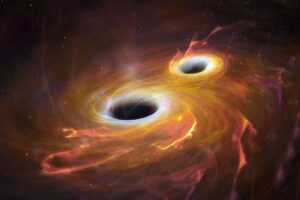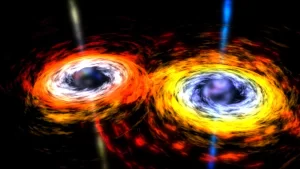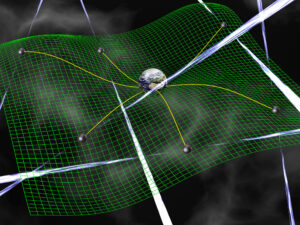Hubble Finds “Missing Link” Black Hole Tearing Apart a Star That Passed Too Close [Video]
![Hubble Finds “Missing Link” Black Hole Tearing Apart a Star That Passed Too Close [Video]](https://aspiredworlds.com/wp-content/uploads/2022/07/Mid-Sized-Black-Hole-Eating-Star-scaled-1-1024x576.jpg)
Hubble Finds “Missing Link” Black Hole Tearing Apart a Star That Passed Too Close [Video]
High-decision imaging exhibits black hollow’s hideout in extra-galactic big name cluster.
Like detectives cautiously constructing a case, astronomers collected proof and removed suspects till they discovered the high-quality proof but that the loss of life of a celebrity, first witnessed in X-rays, can be traced lower back to an elusive mid-sized black hollow. The end result is a long-sought win for astronomy, because the mid-sized “lacking link” withinside the black hollow own circle of relatives has to this point thwarted detection. NASA’s Hubble Space Telescope turned into used to comply with up on more than one X-ray observations of a suspected tidal disruption event. This is precipitated whilst a wayward big name comes too near the gravity properly of a black hollow and receives shredded through its tidal forces. The excessive warmth from stellar cannibalism betrays the black hollow’s presence with a burst of X-rays. Hubble resolved the supply location of this X-ray flare as a celebrity cluster outdoor the Milky Way galaxy. Such clusters were taken into consideration possibly locations to discover an intermediate-mass black hollow. The discovery removed the opportunity that the X-rays got here from every other kind of supply withinside the Milky Way.
Astronomers have discovered the high-quality proof for the wrongdoer of a cosmic homicide: a black hollow of an elusive elegance regarded as “intermediate-mass,” which betrayed its life through tearing aside a wayward big name that handed too near.
Weighing in at approximately 50,000 instances the mass of our Sun, the black hollow is smaller than the supermassive black holes (at hundreds of thousands or billions of sun masses) that lie on the cores of huge galaxies, however large than stellar-mass black holes fashioned through the fall apart of a large big name.
These so-referred to as intermediate-mass black holes (IMBHs) are a long-sought “lacking link” in black hollow evolution. Though there were some different IMBH applicants, researchers don’t forget those new observations the most powerful proof but for mid-sized black holes withinside the universe.
It took the mixed energy of X-ray observatories and the eager imaginative and prescient of NASA’s Hubble Space Telescope to nail down the cosmic beast.
“Intermediate-mass black holes are very elusive objects, and so it’s miles crucial to cautiously don’t forget and rule out opportunity factors for every candidate. That is what Hubble has allowed us to do for our candidate,” stated Dacheng Lin of the University of New Hampshire, most important investigator of the study. The outcomes have been posted on March 31, 2020, in The Astrophysical Journal Letters.
The tale of the invention reads like a Sherlock Holmes tale, regarding the meticulous step-through-step case-constructing essential to capture the culprit.
Lin and his group used Hubble to comply with up on leads from NASA’s Chandra X-ray Observatory and the European Space Agency’s X-ray Multi-Mirror Mission (XMM-Newton). In 2006 those excessive-power satellites detected a effective flare of X-rays, however have been now no longer positive in the event that they originated from inner or outdoor of our galaxy. Researchers attributed it to a celebrity being torn aside after coming too near a gravitationally effective compact item, like a black hollow.
Surprisingly, the X-ray supply, named 3XMM J215022.4−055108, turned into now no longer positioned in a galaxy’s middle, in which large black holes usually might reside. This raised hopes that an IMBH turned into the culprit, however first every other feasible supply of the X-ray flare needed to be dominated out: a neutron big name in our personal Milky Way galaxy, cooling off after being heated to a completely excessive temperature. Neutron stars are the beaten remnants of an exploded big name.
Hubble turned into pointed on the X-ray supply to clear up its specific location. Deep, excessive-decision imaging presents robust proof that the X-rays emanated now no longer from an remoted supply in our galaxy, however as an alternative in a distant, dense big name cluster at the outskirts of every other galaxy — simply the kind of vicinity astronomers predicted to discover an IMBH. Previous Hubble studies has proven that the mass of a black hollow withinside the middle of a galaxy is proportional to that host galaxy’s vital bulge. In different words, the greater large the galaxy, the greater large its black hollow. Therefore, the big name cluster this is domestic to 3XMM J215022.4−055108 can be the stripped down middle of a lower-mass dwarf galaxy that has been gravitationally and tidally disrupted through its near interactions with its cutting-edge large galaxy host.
IMBHs were specially hard to discover due to the fact they’re smaller and much less energetic than supermassive black holes; they do now no longer have easily to be had reassets of fuel, nor as robust a gravitational pull to attract stars and different cosmic fabric which might produce telltale X-ray glows. Astronomers basically should capture an IMBH red-exceeded withinside the act of gobbling up a celebrity. Lin and his colleagues combed thru the XMM-Newton records archive, looking loads of heaps of observations to discover one IMBH candidate.
The X-ray glow from the shredded big name allowed astronomers to estimate the black hollow’s mass of 50,000 sun masses. The mass of the IMBH turned into envisioned primarily based totally on each X-ray luminosity and the spectral shape. “This is a whole lot greater dependable than the use of X-ray luminosity by myself as normally carried out earlier than for preceding IMBH applicants,” stated Lin. “The purpose why we are able to use the spectral suits to estimate the IMBH mass for our item is that its spectral evolution confirmed that it’s been withinside the thermal spectral kingdom, a kingdom generally visible and properly understood in accreting stellar-mass black holes.”
This item isn’t the primary to be taken into consideration a possible candidate for an intermediate-mass black hollow. In 2009 Hubble teamed up with NASA’s Swift observatory and the XMM-Newton X-ray area telescope to discover what’s interpreted as an IMBH, referred to as HLX-1, positioned toward the brink of the galaxy ESO 243-49. It too is withinside the middle of a young, large cluster of blue stars, that could be a stripped-down dwarf galaxy middle. The X-rays come from a warm accretion disk across the black hollow. “The primary distinction is that our item is tearing a celebrity aside, imparting robust proof that it’s miles a large black hollow, as opposed to a stellar-mass black hollow as human beings regularly fear approximately for preceding applicants which includes HLX-1,” Lin stated.
Finding this IMBH opens the door to the opportunity of many greater lurking undetected withinside the dark, ready to accept away through a celebrity passing too near. Lin plans to keep his meticulous detective work, the use of the techniques his group has proved successful. Many questions continue to be to be answered. Does a supermassive black hollow develop from an IMBH? How do IMBHs themselves form? Are dense big name clusters their desired domestic?







